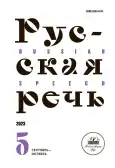Comparative Construction “Kak Griazi” (Dime a Dozen, Lit. Like Dirt) in Diachronic Aspect
- Authors: Sharonov I.A.1,2
-
Affiliations:
- Russian State University for the Humanities
- Pushkin State Russian Language Institute
- Issue: No 5 (2023)
- Pages: 45-51
- Section: Articles
- URL: https://journals.rcsi.science/0131-6117/article/view/250602
- DOI: https://doi.org/10.31857/S013161170028373-9
- ID: 250602
Full Text
Abstract
About the authors
Igor A. Sharonov
Russian State University for the Humanities; Pushkin State Russian Language InstituteRussian Federation, Moscow
References
- Апресян Ю. Д. (отв. ред.). Активный словарь русского языка. Т. 2. М.: Языки славянской культуры, 2014. 736 с.
- Баранов А. Н., Добровольский Д. О. (ред.). Словарь-тезаурус современной русской идиоматики. М.: Мир энциклопедий Аванта+, 2007. 1135 с.
- Баранов А. Н., Добровольский Д. О. (ред.). Фразеологический объяснительный словарь русского языка. М.: Эксмо, 2009. 704 с.
- Баранов А. Н., Добровольский Д. О. От чего зависят стилистические характеристики идиомы (имя им легион VS. их как грязи) // Русский язык в научном освещении. 2009. № 2 (18). С. 78‒91.
- Денисов П. Н., Морковкин В. В. (ред.). Учебный словарь сочетаемости слов русского языка. М.: Русский язык, 1978. 686 с.
- Крысин Л. П. Человек в зеркале русской разговорной речи (лексикографический аспект) // Słowo. Tekst. Chas XI. Szczecin ‒ Greifswald, 2012. С. 539‒547.
- Крысин Л. П. (отв. ред.). Толковый словарь разговорной русской речи. Вып. 1. М.: Языки славянской культуры, 2014. 776 с.
- Кузнецов С. А. (гл. ред.). Большой толковый словарь русского языка. СПб.: Норинт, 1998. 1534 с.
- Мокиенко В. М. Словарь сравнений русского языка. СПб.: Норинт, 2003. 603 с.
- НКРЯ ‒ Национальный корпус русского языка [Электронный ресурс]. URL: www.ruscorpora.ru (дата обращения 15.03.2023).
- Розина Р. И. Стратегия концептуализации предикатной лексики: глаголы порчи (загрязнения) ‒ семантика, сочетаемость, аспектуальное поведение // Труды Института русского языка им. В. В. Виноградова. XX. Взаимодействие лексики и грамматики. М., 2019. С. 256–267.
- Федоров А. И. (ред.). Фразеологический словарь русского литературного языка конца XVII – XX в. Т. 1. Новосибирск: Наука, 1991. 337 с.









